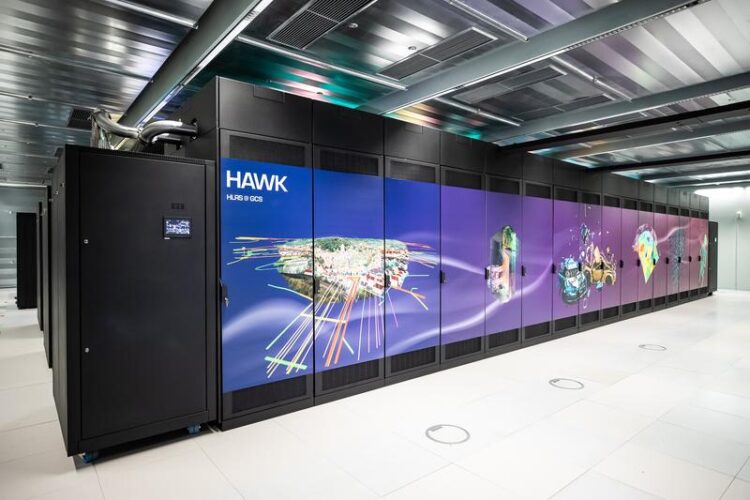New Possibilities for Artificial Intelligence

HLRS's flagship supercomputer, called Hawk. (Photo: HLRS)
Hawk Supercomputer at the University of Stuttgart Gets Upgrade.
The High-Performance Computing Center of the University of Stuttgart (HLRS) will add NVIDIA graphic processing units (GPUs) to its world-class supercomputer, Hawk. The change in architecture from a purely central processing unit (CPU)-based architecture to a hybrid system will enhance HLRS’s capacity for deep learning applications and enable new kinds of workflows that combine simulation using high-performance computing and Big Data methods.
“At HLRS our mission has always been to provide systems that address the most important needs of our key user community, which is largely focused on computational engineering,” explained HLRS Director Dr.-Ing. Michael Resch. “For many years this has meant basing our flagship systems on CPUs to support codes used in computationally intensive simulation. Recently, however, we have seen growing interest in deep learning and artificial intelligence (AI), which run much more efficiently on GPUs. Adding this second key type of processor to Hawk’s architecture will improve our ability to support scientists in academia and industry who are working at the forefront of computational research.”
One of Europe’s top supercomputers becomes more versatile
Hawk, a Hewlett Packard Enterprise (HPE) Apollo system installed in 2020, is already one of Europe’s most powerful high-performance computing (HPC) systems. It recently placed 16th in its debut on the Top500 list of the world’s fastest supercomputers, based on the High-Performance Linpack (HPL) benchmark.
With the signing of a new agreement with HPE, HLRS will now expand this world-class supercomputer by adding 24 HPE Apollo 6500 Gen10 Plus systems with 192 NVIDIA A100 GPUs based on the NVIDIA Ampere architecture. The addition of 120 petaflops of AI performance will give HLRS’s users the ability to run deep learning, high-performance data analytics, and artificial intelligence applications on the same system they currently use for computing-intensive simulation.
Hybrid workflows that integrate HPC and AI can accelerate computational engineering
Although some have speculated that AI could eventually replace high-performance computing, the truth is that some of today’s most interesting research is combining these technologies.
Deep learning algorithms typically require the generation of enormous amounts of training data as input — a task that is perfectly suited to large, CPU-based high-performance computers like Hawk. Conversely, models created using deep learning on GPU-based systems can help researchers more efficiently sift through massive datasets to find valuable insights. Users of HLRS’s HPC resources have already begun investigating how such hybrid approaches could accelerate research in fields such as computational fluid dynamics, combustion, robotics, and manufacturing.
“Once the NVIDIA GPUs are added to Hawk, hybrid workflows combining HPC and AI will become much more efficient,” said Dennis Hoppe, who leads artificial intelligence activities at HLRS. “Losses of time that occur because of data transfer between different computing systems and the need to run different parts of the workflows in separate stages will practically disappear. Users will be able to stay on the computing cores they are using, run an AI algorithm, and integrate the results immediately.”
About the High-Performance Computing Center of the University of Stuttgart
The High-Performance Computing Center Stuttgart (HLRS) was established in 1996 as the first German national high-performance computing center, building on a tradition of supercomputing at the University of Stuttgart that stretches back to 1959. As a research institution affiliated with the University of Stuttgart and a founding member of the Gauss Centre for Supercomputing — the alliance of Germany’s three national supercomputing centers — HLRS provides state-of-the-art HPC services to academic users and industry.
HLRS operates one of Europe’s most powerful supercomputers, provides advanced training in HPC programming and simulation, and conducts research to address key problems facing the future of supercomputing. Among HLRS’s areas of expertise are parallel programming, numerical methods for HPC, visualization, grid and cloud computing concepts, data analytics, and artificial intelligence. Users of HLRS computing systems are active across a wide range of disciplines, with an emphasis on computational engineering and applied science.
Wissenschaftliche Ansprechpartner:
Prof. Dr.-Ing. Michael Resch, University of Stuttgart, High-Performance Computing Center Stuttgart (HLRS), Tel.: +49 (0) 711 / 685-87200, resch@hlrs.de
Weitere Informationen:
Media Contact
All latest news from the category: Information Technology
Here you can find a summary of innovations in the fields of information and data processing and up-to-date developments on IT equipment and hardware.
This area covers topics such as IT services, IT architectures, IT management and telecommunications.
Newest articles

An Endless Loop: How Some Bacteria Evolve Along With the Seasons
The longest natural metagenome time series ever collected, with microbes, reveals a startling evolutionary pattern on repeat. A Microbial “Groundhog Year” in Lake Mendota Like Bill Murray in the movie…

Witness Groundbreaking Research on Achilles Tendon Recovery
Achilles tendon injuries are common but challenging to monitor during recovery due to the limitations of current imaging techniques. Researchers, led by Associate Professor Zeng Nan from the International Graduate…

Why Prevention Is Better Than Cure—A Novel Approach to Infectious Disease Outbreaks
Researchers have come up with a new way to identify more infectious variants of viruses or bacteria that start spreading in humans – including those causing flu, COVID, whooping cough…



